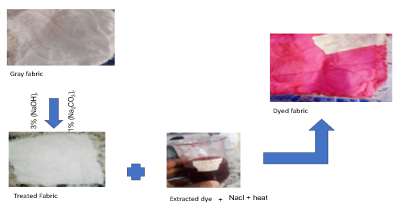
Keywords
Cotton fabric dyeing,Color fastness,Natural dye,Sustainable textile production,Vaccinium corymbosumHow to Cite
(1)
Musa Abubakar , Y.; Garba, F.; Muhamad, M. A.; Bioltif , Y. E.; Bilyamin Adam, A.; Usman , L. Optimization of Dyeing Conditions of Natural Dye Obtained from Vaccinium Corrymbosum (Blueberry) On Cotton Fabric. Orbital: Electron. J. Chem. 2025, 16, 253-257.




Using plants as natural sources of dyes promotes sustainable practices in textile production by reducing reliance on synthetic dyes, which often pose environmental and health concerns. Vaccinium corymbosum (blueberry) is a commercially and culturally significant plant, providing nutritious fruit and supporting biodiversity in its native habitats. In this study, natural dye extraction from V. corymbosum was performed using a mixture of 15 ml methanol, 20 ml distilled water, and 1% HCl. The extracted dye was optimized for dyeing cotton fabric by studying the effects of dye concentration, temperature, and dyeing time. Dye concentrations were varied at 0.1, 0.15, 0.25, and 0.3 g/cm³, with the optimum concentration identified as 0.3 g/cm³. Dyeing temperatures were adjusted to 60, 70, 80, 90, and 100 °C, with optimal results at 90 °C. Dyeing times were varied at 30, 40, 50, 60, and 70 minutes, with 70 minutes being the optimal duration. Color fastness of the dyed fabrics was assessed using a gray scale. Results showed that wash fastness was good (rating of 3), perspiration fastness in acidic and basic media ranged from fairly good (rating of 2) to better (rating of 3.5), and light fastness was moderate (rating of 5). The study found that increasing dye concentration led to greater dye absorption by the fabric. As temperature increased from 60 to 90 °C, dye molecule movement accelerated, enhancing diffusion into the fiber structure and resulting in deeper, more intense coloration. However, at 100 °C, excessive heat caused bond breakage, leading to faded colors. Extended dyeing time also improved the dye fastness on the fabric. This research demonstrates the potential of V. corymbosum as a natural dye source, contributing to more sustainable textile dyeing practices.
留言 (0)